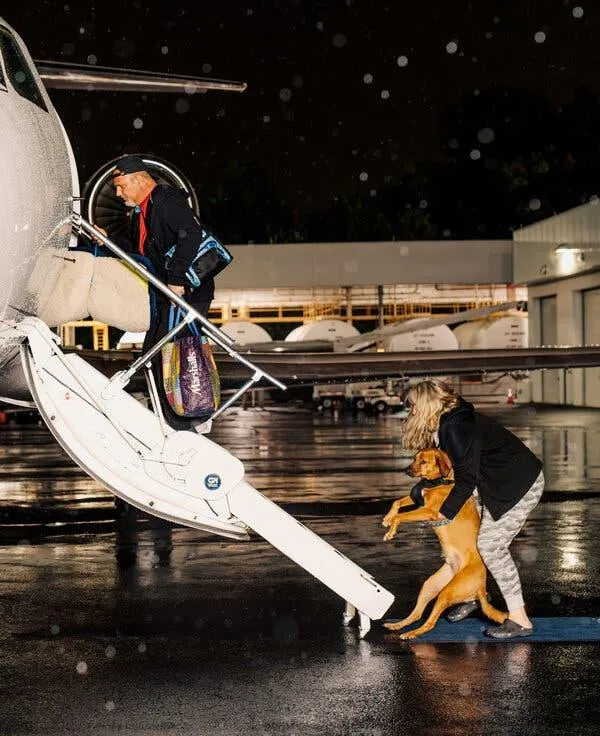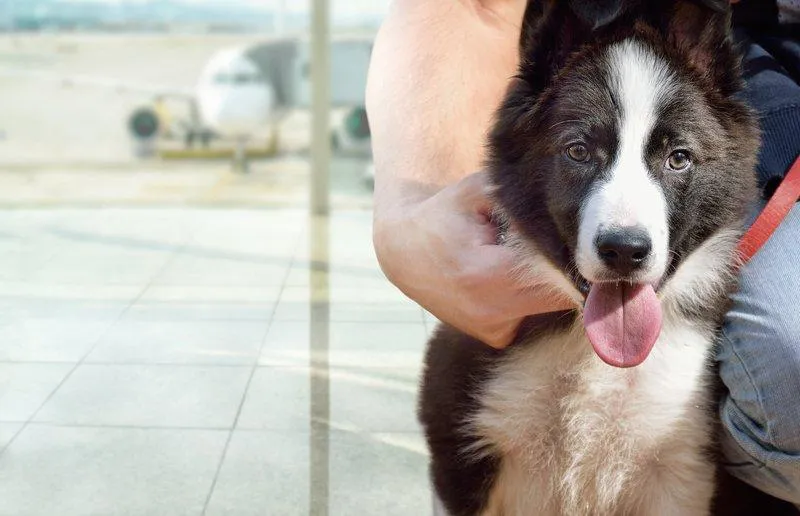A Guide to Flying with Your Large Dog
Whether you’re moving to a new home or going on a family vacation, traveling by plane with your big furry friend can seem like an overwhelming task. However, with some advance planning and understanding of airline policies, you’ll be able to take Fido flying with you. In this article, I’ll cover everything you need to know to make traveling with a large dog by air as stress-free as possible for you and your pup.
Choose the Right Airline
- Most major airlines like Delta, American, and United allow dogs in the cargo hold of passenger planes, but size and breed restrictions apply. Be sure to verify the airline’s policies and restrictions for your dog’s breed and weight before booking tickets.
- Some budget carriers like Frontier don’t accept any pets at all for transport in the cargo hold. You’ll want to avoid these if flying with a large dog.
- A few airlines, including Alaska and JetBlue, allow dogs to travel in the cabin as carry-on luggage subject to size limits. For oversized dogs, this is often a much calmer travel option compared to cargo.
From my experience flying with dogs of different sizes, I can say most are fairly lenient with weight limits but very strict on height and length restrictions when it comes to cabin pets. Measure your pup and check policies carefully to avoid surprises.
Prepare Proper Paperwork
Regardless of whether your dog is flying in the cargo hold or cabin, the airline will require:
- A certificate from a licensed veterinarian stating the dog is healthy, has received all required vaccines in the past year, and fit to travel.
- Proof of vaccinations such as a rabies title should be carried on the flight, not mailed separately.
- An ISO-approved travel crate just big enough for your dog to stand up and turn around in.
- Two copies of an updated profile with your contact details in case of emergency.
Don’t forget ID tags on your dog’s collar too! Airlines won’t accept pets without proper ID in case they get separated from their crate during transport. Start preparing docs 2 months in advance to allow time for any vet visits.
From my experience, imperfect paperwork is a huge reason flights with pets get delayed or dogs may not be allowed to board at all. Have everything triple checked to avoid hassle on travel day.
Pre-Travel Training
Even friendly dogs can feel anxious about flying, so its wise to do some training before the big day:

- Get your dog used to their crate with positive reinforcement and treats. Practice short periods inside and work up to several hours.
- Desensitize them to noisy sounds like fans, loud voices or common airport distractions to minimize fear responses.
- Practice crate games to build happy associations and reduce stress. For example, feeding meals inside or just hanging out together.
- Consider anxiety medications prescribed by your vet. These can take the edge off for highly nervous flyers without fully sedating them.
The more comfortable your dog feels in their personal space, the calmer they’ll be on the journey. Don’t leave pre-travel training to the last minute.
Prepare for Travel Day
Set your furry friend up for success at the airport with these logistics:
- Fast your dog 4-6 hours before the flight to prevent nausea. Offer water until 2 hours prior to boarding.
- Use a comfortable collar or harness, never a retractable lead which can get tangled at security.
- Bring water, toys or treats to keep pups occupied in the terminal if there’s a wait.
- Find parking near the terminal if possible to minimize walk time and stress.
- Inform the airline at check-in if an emotional support note or separation anxiety is an issue.
From my experience, stressed pets pick up on owner anxiety. Stay calm, reassuring and matter-of-fact to set a chill example. With preparation, even high strung dogs can make it through to their destination.
During the Flight
Unfortunately there’s no window seats or in-flight snacks for pets flying cargo. To help Fido feel supported:
Some airlines let owners check on dogs during layovers using cameras in kennel areas. Others offer to move pets to earlier flights if available with bad weather forecast. Ask staff about these options since a delay could totally bum a dog out, dude!
While cargo conditions can’t match home comforts, most pups tolerate transport better than we expect due to natural resilience. As long as health and safety standards are met, try to relax and remember your buddy won’t be down there forever.

Still worried? Ask your vet about a mild calming aid for nervous flyers. While sedatives aren’t recommended by all experts, a low dose of something like melatonin or magnesium can take the edge off for some high strung pups. At the same time, medication should never make them unable to stand or thermoregulate.
Arrival and Beyond
The end is in sight once you pick up your pooch!
- Check for any issues as soon as you reunite – signs of dehydration, injury or illness warrant an immediate vet visit.
- Offer water right away if offered any food, offer bland easy to digest options like boiled chicken and rice at first to avoid tummy troubles.
- Settle into new surroundings slowly with walks, playtime and low-key interactions to help wind down from stress hormones.
- Watch for residual anxiety, restlessness or changes in potty habits over the next few days as your pup readjusts to “normal”.
Even with the best planning, travel days take it out of humans and dogs alike. Be prepared to pamper your pooch with low-key activities, favorite toys and treats for reassurance. Most bounce back quickly but a few need extra TLC to feel comfy again.
Hopefully this guide has helped shed some light on issues you may face flying with a large dog! While not risk or hassle-free, research safe options and plan in advance and most journeys go smoothly. With preparation and patience, you can get Fido where he needs to go. Feel free to ask me any other questions as you start booking your pet-friendly itinerary. Safe travels to you and your furry companion!
“How to Take Your Big Dog on a Plane”
| Airline | Weight limit | Crate size | Crate requirement | Booking requirements |
|---|---|---|---|---|
| Delta | 70 lbs | Large-sized dog crate | Required | Book at least one day in advance |
| American | 100 lbs | Oversized dog crate | Required | Book at least two weeks in advance |
| United | 125 lbs | Extra-large dog crate | Required | Book at least one month in advance |
| Alaska | No limit | Crate not required | On leash OK | Book at least two days in advance |
| JetBlue | 150 lbs | Oversized crate or on leash | Not required | Book at least one week in advance |
FAQ
-
Is it legal to bring my big dog on a plane?
Basically yeah, as long as your pup meets the airline’s size and health requirements. Most carriers allow dogs under 20 pounds in the cabin for a fee. You’ll need to put Fido in an approved carrier that fits under the seat.
-
What documents do I need?
You’ll basically need your pup’s vaccination records showing they’re up to date on all shots. The airline might also require a health certificate from your vet within 10 days of travel. It’s a good idea to check the specific airline rules, because they can differ somewhat.

-
How do I pick the right airline?
Checking online reviews can help sort out which carriers are most pet-friendly. Some even offer “pet-only” flights with extra room for dogs in the cabin. At the same time, smaller regional lines have tighter space, so a little dog might work better than a big one.
-
What size carrier is best?
The safe size depends on your pup. An XXL dog needs an equally huge crate, obviously. But even medium breeds should have space to stand up and turn around. Look for airline dimension rules, but a general guideline is 17-19 inches high by up to 24 inches long.
-
How do I keep my dog calm?
Bring along some comforting teddy bears or toys that smell like home. Speaking softly and giving treats or praise through the trip will help reassure an anxious dog. It might also help to ask your vet about calming aids, if flying really freaks out Fido.
-
Is it worth the hassle and cost?
For some dogs, the stress isn’t worth it. But for others, it’s the only way to take a vacation with your pup. As long as you plan extra time for check-in and are realistic about potential issues, it can absolutely be worth it to bring your best bud along. At the same time, training your dog to be calm in the carrier is crucial.
-
What could go wrong?
Mostly normal flying issues, like delays and missed connections, apply to pets too. But there’s always a chance of an escape artist dog who panics in the station. Using a safe carrier designed for animals and keeping papers in order will minimize hassles. Nevertheless, be prepared for surprises, since emergencies happen sometimes even with the best laid plans. Overall the odds are good if you prepare well.
Some experts suggest considering car travel as an alternative if flying stresses the dog too much. Despite being slower, road trips allow more comfort stops and flexibility. On the other hand, for dogs accustomed to carriers, planes can work out great. Just be sure to check rules and expectations with your chosen airline. The facilities, level of service, and tolerance for pet issues varies widely between carriers.

In closing, there are a lot of options to ponder when taking a big dog on a plane. Using common sense, getting your vet’s advice, knowing your pooch’s personality and putting safety first should set you and Fido up for a successful journey. With care and preparation, canine companions don’t have to be left behind on vacations.
